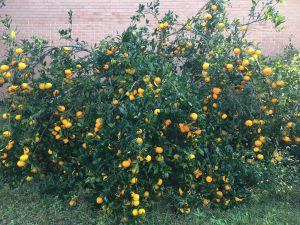When asked what kind of citrus to grow here in North Florida, my default response is satsuma. I usually get a funny look, followed by an attempt by the person who’s asking to repeat the name satsuma. The individual may ask, “What is satsuma… is that a citrus?” I guess the person expected to hear orange, grapefruit, lemon or maybe tangerine.
Satsuma is a type of citrus, technically classified as a mandarin and is sometimes referred to as satsuma mandarin. The satsuma mandarin is a good candidate for the North Florida citrus enthusiast for a number of reasons.
- Historically, mature dormant trees have survived minimum temperatures of 14°F to 18°F when budded/grafted to a cold-hardy rootstock such as trifoliate orange or swingle, a trifoliate orange cross. Young trees are not as cold-hardy but, due to their smaller size, are more easily covered with a cloth such as a sheet or lightweight blanket for protection during freezes.
- Satsuma fruit are ready to harvest October through December, ripening before the coldest winter temperatures. This is not true with most sweet citrus types such as oranges, which are harvested during winter months. Harvesting during winter works well in Central and South Florida where winters are mild but does not work well here in extreme North Florida. The potentially colder winter temperatures of North Florida are likely to result in the fruit on sweet oranges freezing on the tree before they are ripe, potentially ruining the fruit.
- Our cooler fall temperatures result in higher sugar content and sweeter fruit.
- Fruit are easily peeled by hand, have few to no seed and are sweet and juicy.
- Trees are self-fruitful, which means that only one tree is needed for fruit production. This is important where space is limited in a home landscape.
- Trees are relatively small at maturity, reaching a mature height of 15 to 20 feet with an equal spread.
- Branches are nearly thornless. This may not be true with shoots originating at or below the graft union. Shoots coming from the rootstock may have long stiff thorns. These shoots should be removed (pruned out) as they originate.
Satsuma fruit are harvested in fall but trees are best planted during springtime when temperatures are mild and as soil is warming. Availability of trees is normally better in spring, as well. For additional cold protection, purchase a satsuma grafted on trifoliate orange rootstock and plant the tree on the south or west side of a building. There are a number of cultivars from which to choose.
For more info on selecting and growing satsuma mandarin, contact the UF/IFAS Extension Office in your County or visit the following website.
https://edis.ifas.ufl.edu/ch116
- Neighborhood Lawn Guru Kills Lawns, Leaves Town - March 22, 2024
- Rollercoaster Temperatures in NW Florida - February 8, 2024
- Muscadine Grapes, a Southern Treat - January 11, 2024

